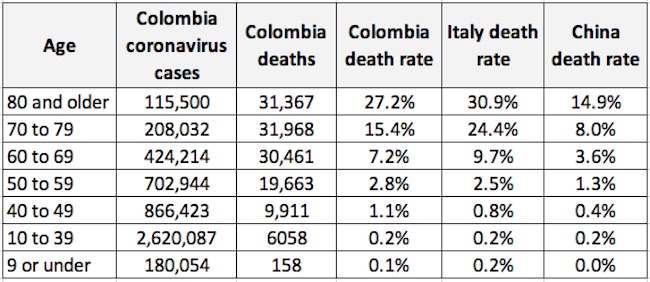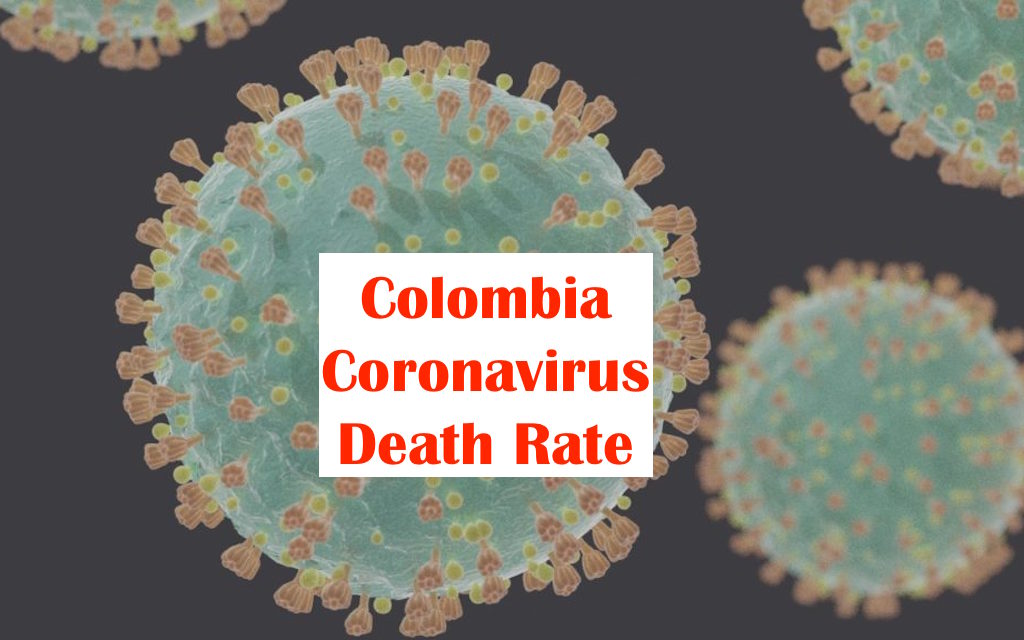We look at the Coronavirus death rate in Colombia for different ages. We also look at the Coronavirus recovery rate in Colombia.
Several Medellin Guru readers have asked about the coronavirus death rate in Colombia by age if they happen to get infected. And we haven’t seen this published anywhere in English, so we researched this.
Colombia Ministerio de Salud (Ministry of Health) reported the number of coronavirus cases in Colombia on December 24 – a total of 5,115,194 cases with 129,686 deaths.
Keep in mind that the death rates we look at in this article are based on confirmed cases. The World Health Organization (WHO) previously estimated that the death rate among confirmed coronavirus cases (“case fatality rate” or CFR) is about 3.4 percent worldwide but this varies by country.
In addition, WHO held a two-day online meeting of 1,300 scientists from around the world in early July. And the agency’s chief scientist, Dr. Soumya Swaminathan, said the consensus for now was that the infection fatality rate (IFR) for coronavirus is about 0.6 percent globally — which means that the risk of death is less than 1 percent. But this can vary by region and country.
However, IFR is difficult to calculate and depend on estimates, as IFR requires knowing how many are infected, not just how many have diagnosis confirmed with tests.
The death rate also depends on a range of factors like your age and general health, as well as the medical care you have access to.
Furthermore, an analysis of more than 44,000 cases from China found that deaths were at least five times more common among confirmed cases with diabetes, high blood pressure or heart or breathing problems.
Colombia Coronavirus Death Rate
Based on a total of 128,643 deaths and a total of 5,115,194 cases, the overall coronavirus death rate in Colombia among confirmed cases on December 24 was 2.53 percent.

Coronavirus death rate by age in Colombia, data source: Instituto Nacional de Salud, Dec. 24
Also, in the above table we compare the death rate in Colombia by age with Italy and China. Colombia’s coronavirus death rate by age so far is relatively similar to what was experienced in Italy. Note this death rate is the case fatality rate (CFR) that is number of deaths divided by number of cases.
In addition, it is important to note that 72.9 percent of the coronavirus deaths in Colombia as of December 24, 2021 have been aged 60 or older.
Colombia’s Ministry of Heath way overestimated the death rate in Colombia from coronavirus. Colombia initially estimated that by May 2020, Colombia would have 2,500 deaths from coronavirus but the actual number on May 31 was only 939 deaths.
Note that there is a lag between the dates of actual deaths from coronavirus and reporting of deaths. So, the above chart of daily reported deaths does not show the true picture.
So, the below chart of daily reported deaths does not show the true picture. For example, the following chart shows that on November 23, 2021, 46 of the 50 reported deaths on that date actually occurred on earlier dates. This chart shows that the daily coronavirus deaths by actual death dates in Colombia (not reported dates) have been declining since mid-July.

Daily coronavirus deaths in Colombia on the actual dates of deaths, source: Instituto Nacional de Salud, November 23
Coronavirus Death Rate Per Million
As of December 24 Colombia was experiencing a Coronavirus death rate of 2,509 per million population in the country based on confirmed deaths.
Furthermore, Colombia is experiencing a lower Coronavirus death rate per million population compared to some countries as seen in the following table:

Coronavirus death rate per million population, source of data Worldometer and countries, December 24
For example, in the table, on December 24, Peru is experiencing a coronavirus death rate that is 2.4 times higher per million in population than in Colombia.
On December 24, Colombia was ranked #20 in the World in terms of coronavirus deaths per million according to Worldometers. Three countries in Latin America had a higher coronavirus death rate per million population than Colombia. The following are country rankings for deaths per million in several Latin American countries from Worldometers on December 24.
- Peru #1
- Brazil #13
- Argentina #18
- USA #19
- Colombia #20
- Paraguay #25
- Mexico #26
- Chile #34
- Ecuador #41
- Uruguay #46
- Panama #51
The Death Rate in Confirmed Cases is Not the Overall Death Rate
Keep in mind that most cases of viruses tend to go uncounted because people generally do not to visit the doctor with mild symptoms.
The first death rate used in this article is the “case fatality rate” (CFR), which is the most commonly used measure of the risk of dying, as it can easily be measured and is not an estimate. This is simple to calculate, as it is dividing the confirmed coronavirus deaths by the confirmed coronavirus cases. On December 24, this was 2.53 percent for Colombia.
The second death rate used in the article is the “crude mortality rate” (CMR), which measures the probability that any individual in the population will die from the disease. This is calculated by dividing the number of deaths from the disease by the population. For Colombia this was 2,509 per million or 0.251 percent on December 24.
We do not use a third death rate in this article known as “infection fatality rate” (IFR), as this depends on knowing how many are infected. The total number of cases is not known since most cases of viruses tend to go uncounted because people generally do not to visit the doctor with mild symptoms. So, the IFR cannot be accurately calculated, at best it is an estimate.
How deadly is coronavirus? Scientists are searching for an answer. As mentioned above at the beginning of this article, the World Health Organization (WHO) held a two-day online meeting of 1,300 scientists from around the world in early July.
As a result of this meeting, the agency’s chief scientist, Dr. Soumya Swaminathan, said the consensus for now was that the infection fatality rate (IFR) for coronavirus is about 0.6 percent globally — which means that the risk of death is less than 1 percent. But this can vary by region and country.
That means the global infection fatality rate (IFR) for coronavirus was estimated by WHO in July at 0.6 percent.
Colombia Coronavirus Recovery Rate
On December 24, 2021 in Colombia, 4,955,539 out of 5,118,284 cases on this date had recovered, which is a recovery rate of 96.85 percent of the total coronavirus cases. So, over 97 percent of the coronavirus cases in Colombia as of December 24 had recovered.
In the month of March 2020 when the pandemic started, the number of daily recoveries from coronavirus were less than 40 each day.
A WHO analysis of Chinese coronavirus data showed that it takes two weeks on average to recover from COVID-19.
Recovery time also depends on how sick you become in the first place. Some people will recover quickly. But for others an infection could leave lasting problems.
Most people who are infected with COVID-19 develop only the main symptoms, which are a cough or fever. In addition, they could experience headaches, body aches, fatigue and a sore throat. These symptoms are treated with plenty of fluids, bed rest and pain medication.

Colombia has 23 of the Best Hospitals in Latin America
Healthcare in Colombia
Colombia has 24 of the top 58 clinics and hospitals in Latin America, according to a study in late 2019 by América Economia. So, 41 percent of the best hospitals in Latin America are found in Colombia. Nine of these best hospitals in Latin America are located in Medellín and nine are in Bogotá.
In 2018, Colombia had 23 of the top 58 hospitals. So, the count in 2019 increased to 24 of the top 58 clinics and hospitals in Latin America for 2019.
In addition, the World Health Organization (WHO) ranks Colombia’s healthcare system as #22 out of 191 countries it ranked. And no other countries in Latin America were ranked higher than Colombia. So, according to WHO, Colombia has the best healthcare system in Latin America.
Also, Colombia’s healthcare system is ranked higher than many wealthier countries like the United States (#37), Germany (#25), Canada (#30) and Australia (#32).
In Colombia, it is possible to have access to world-class healthcare at a fraction of the cost compared to the healthcare costs in North America or Europe. Furthermore, the costs for healthcare in Colombia can be significantly lower than the costs found in the U.S.
Due to having the best healthcare system in Latin America, Colombia is probably better positioned than many other countries in Latin America to handle coronavirus.
Health Insurance in Colombia
Health insurance is relatively inexpensive in Colombia and will cover you if you happen to catch COVID-19.
One of the reasons that Colombia has such a highly rated healthcare system is due to a new constitution that Colombia drafted in 1991 that made access to healthcare a basic human right to all citizens of Colombia, as well as foreign residents of Colombia.
There are three types of health insurance available in Colombia:
- EPS – Entidadas Promotoras de Salud– this is the public health insurance that is mandatory for everybody who is a resident of Colombia. The monthly premium is calculated as 12.5 percent of the monthly gross income that you declare to the EPS.
- Prepagada – this is private healthcare insurance in Colombia. The monthly premium for Prepagada varies depending on your age, the plan you choose and any pre-existing conditions.
- SISBEN – this is a free government subsidized healthcare system, which is only for very poor or homeless Colombians.

Medellin Guru has partnered with an insurance agent to offer health insurance and other insurance products like life insurance, homeowners insurance and auto insurance to foreigners and Colombians.
We partnered with Insurance Agent, who is a bilingual insurance agent who speaks English and Spanish. And she has many foreigner clients.
Use the Medellin Guru Insurance Service
Over 215 Medellin Guru readers have obtained insurance in Colombia through our insurance agent partnership including health insurance, auto insurance, homeowners insurance, life insurance and travel insurance.
Insurance Agent offers insurance services to all foreigners and Colombians who need assistance in their process of finding the best insurance protection while living in Colombia. With over ten years of experience, they design the plan that best fits your needs allowing you to enjoy your life abroad.
Medellin Guru’s Coronavirus Series
Medellin Guru has a series of articles about the coronavirus pandemic and the impacts in Colombia: Also, these articles are being kept up-to-date, as this is a fast-moving topic:
- Colombia Needs to Ramp up COVID-19 Vaccinations
- Is Colombia Starting to Win the Coronavirus Battle?
- Nightly Curfew and Dry Law in Antioquia from March 25 to June 9
- COVID-19 Vaccinations in Colombia Start on February 17
- PCR Test: How to Get a COVID-19 Test in Medellín
- PCR Test: How to Get a COVID-19 Test in Bogotá
- PCR Test: how to Get a COVID-19 Test in Cartagena
- Nightly Curfews in January in Medellin and Antioquia Start on January 6
- Nightly Curfew in Medellín For Christmas and New Year’s Holidays
- Colombia is Buying 10 Million Doses of COVID-19 Vaccine from Pfizer
- Does Colombia Require a COVID-19 Test for International Travelers?
- 8 Reasons Why Colombia is Unlikely to Return to a Quarantine
- Coronavirus Cases Increase in Medellín: What Happens Next?
- New Normal in Medellín: Medellín is Returning to Normal
- Will the Quarantine Return to Colombia? What if Cases Increase?
- New Normal in Medellín: Medellín is Returning to Normal
- Colombia’s Quarantine Ends on September 1: New Phase Starts
- Tourism Impact of Coronavirus: Colombia Starts to Reactivate Tourism
- Economy Impacts in Colombia Due to Extended Quarantine
- Epicenter of Coronavirus in Colombia: Bogotá is the Epicenter
- Medellín Plans the Total Reopening of Economic Activities in the City
- When Will the Quarantine End in Colombia? On September 1?
- Humanitarian Flights from Colombia to the U.S. and Other Countries
- Beware of Fake News in Colombia About Coronavirus and Quarantines
- Reopening Gymnasiums, Churches and Movie Theaters in Colombia
- Reopening Amusement Parks, Zoos and Nature Reserves in Colombia
- Medellín Starts Free COVID-19 Tests on the Medellín Metro
- New COVID-19 Preventive Measures in Medellín to Contain the Pandemic
- Penalties for Violating the Quarantine in Medellín are Stiff
- COVID-19 Orange Alert in Bogotá: New Lockdowns in Bogotá
- Medellín Starts to Lift the Quarantine: Enters Smart Isolation Phase
- Colombia Started to Lift the Quarantine – What Does this Mean?
- Coronavirus: When Will the Quarantine Be Lifted in Colombia?
- Colombia Starts to Lift the Quarantine in COVID-19 Free Areas
- Colombia Quarantine: Nationwide Quarantine Extended to September 1
- Coronavirus in Colombia: Myth vs Reality – Current Status
- Coronavirus Hospitalization in Colombia: Myth vs Reality
- Are Medellín and Antioquia Winning the Coronavirus Battle?
- 23 Cities with a Major Increase in Coronavirus Cases in Colombia
- Colombia Coronavirus Death Rate: What are the Chances of Dying?
- Coronavirus: When Will Things Return to Normal in Colombia?
- COVID-19 Testing in Colombia: Realty About Coronavirus Testing
- Life as an Expat: During Medellín’s Coronavirus Quarantine
- Colombian Visa Process Changes: Due to Quarantine and Coronavirus
- Medellín Coronavirus Closures – What is Closed in Medellín?
- Pico y Cedula: A Restriction for Grocery Shopping in the Aburrá Valley During the Quarantine
- Pico y Cedula in Colombia: Which is Strictest Out of 5 Largest Cities?
- Medellín Quarantine Starts on March 20 for Four Days
The Bottom Line: Colombia Coronavirus Death Rate – What are the Chances of Dying?
Colombia is experiencing a lower coronavirus death rate per million than in Brail or Peru.
The bottom line answer to foreigners asking about the Colombia coronavirus death rate is that you have a higher chance of dying the older you are. This is just like in other countries.
The lowest death rate in Colombia out of confirmed cases is for those aged 9 or under – only 0.1 percent as of December 24, 2021. This compares to 26.9 percent for those over 80 years-old.
Also, it is notable that 72.9 percent of the coronavirus deaths in Colombia as of December 24, 2021 have been aged 60 or older.
Also, underlying health conditions such as asthma, cancer, pulmonary disease, heart disease, kidney disease, liver disease and diabetes put you at greater risk with coronavirus.
Stay safe! And protect yourself from COVID-19 by:
- Staying home as much as possible.
- Avoiding close contact with people who are sick.
- Put distance between yourself and other people when you are out.
- Avoid touching your eyes, nose, and mouth with unwashed hands.
- Wash your hands often with soap and water for at least 20 seconds.
- Wear a face mask.
Sign up for the Free Medellin Guru Newsletter – You can see all of the previous Medellin Guru weekly email newsletters and sign up here.
Editors note: updated on November 22, 2021 with Colombia coronavirus, death and recovery statistics from November 21.
Editors note: updated on November 28, 2021 with Colombia coronavirus, death and recovery statistics from November 27.
Editors note: updated on December 4, 2021 with Colombia coronavirus, death and recovery statistics from December 3.
Editors note: updated on December 25, 2021 with Colombia coronavirus, death and recovery statistics from December 24.





































19 thoughts on “Colombia Coronavirus Death Rate: What are the Chances of Dying?”
Thanks for the update. I have some friends that left Colombia a few months ago for California saying things would get worse in Colombia. Look at California now, 100 percent ICU occupancy.
Thanks for the update. Nice to see Colombia still has a lower death rate than several countries in Latin America.
How is the hospitalization now?
Can you please write on ICU capacity per city. I understand Cartagena is now approx 53% capacity. How are the other cities?
Today I posted the odds of dying from COVID-19 in the United States which are 1 in 2,312. The odds of dying in a vehicle accident in the U.S. are 1 in 103. I doubt seriously that your odds of dying of coronavirus are greater in Colombia.
Drawing by numbers. If you like to draw it in number, here is the difference: People who die by a car accident usually do not infect others. A Pandemic effect cannot be compared that easily to a 1:1 or 1:n effect. Example. Let’s take a Reproduction Rate of 2. Quite possible here. So every person who is infected infects 2 more persons. After a week that’s a total of 160 persons. After 2 weeks it would be over 20.000 persons.
The chance to actually “die” on Corona is low, of course. In case of serious development in the disease, let’s take the worst case, you will put to an ICU. Actually, the machine doesn’t help a lot, since it needs a skilled and experienced operator. I would say: The chance to find an experienced operator in Colombia and a free spot in a hospital with an ICU in Colombia is significantly small then for example in Germany. So the answer is: Yes, the odds of dying of coronavirus (COVID-19, Corona is just the family of the virus) are greater.
38,000 people die in the USA every year from car accidents. Five to ten times that number will die from Covid in 2020. Yet you are saying the odds of dying in a vehicle crash are greater than Covid? Total nonsense.
Hey Guys,
My wife is in Bucaramanga and I am in South Carolina. Haven’t seen her since March. Very sad. Needless to say, I have been watching the situation very close. With the help of Medellin Guru, Iv’e been able to keep up with the situation. Thanks so much!!
Iv’e been crunching numbers to try to keep a grip on whats going on in the world.
Check out my method of calculating the death rates in all countries. I have been keeping a graph of deaths -to-closed cases. Closed cases can be calculated by subtracting the active cases from the total.
Then if you divide deaths into closed cases, it gives you a trailing by about three weeks figure, but very accurate.
For example, using this trailing method for Colombia: 117,110 total cases – 64,907 active = 52,203 closed.
Then 4064 deaths divided by 52,203 closed cases = 7.78 percent deaths to closed cases with outcomes.
This trailing method gives us a glimpse at what the virus is leaving behind. Right now, according to this method, it is taking the lives of one person in twelve. (7.78percent)
Right now according to Worldmeter there are 1,423,298 closed cases, and 132,616 deaths in the US.
So, 132,616 deaths divided by 1,423,298 closed cases = 9.3 percent death to closed cases, so, 1 person in every 10.75 people who get infected.
I hope this is helpful to everyone. It’s just another perspective.
Jeff, I can’t thank you enough for your hard work on this site!
Stay safe
David
I have seen no researcher or scientist calculate death rate based just on closed cases.
Researchers base it on deaths per total cases – “case fatality rate” (CFR), deaths per population – “crude mortality rate” (CMR) or deaths per estimates of how many are infected – “infection fatality rate” (IFR). And scientists are still struggling to learn how often the virus kills… https://www.nytimes.com/2020/07/04/health/coronavirus-death-rate.html
Yes, they are. They are learning more and more as time goes on.
They keep up with the deaths to closed cases on Worldmeter because the average three week “active” period has not yet had any outcomes and thereby can’t accurately be included in the death to life equation until they have had an outcomes.
Check out this link: https://www.worldometers.info/coronavirus/country/us/
Don’t see anything in that link that shows they do.
See how they calculate Coronavirus (COVID-19) Mortality Rate or “infection fatality rate” (IFR) for NYC, which is based on an estimate for deaths and an estimate for cases (infected) and is not based on reported closed cases – https://www.worldometers.info/coronavirus/coronavirus-death-rate/
Hi Jeff,
Good article, thank you.
The true death rate will not be known until after the pandemic is over. This is because there can be a delay of a few weeks, or over a month, between someone becoming infected with the virus before they die or recover fully. And, as you mention, there are those who suffer with “long Covid”.
Interestingly in Europe death rates have been falling, one theory is that the amount of virus a person is exposed to affects the severity of the illness. So measures such as mask wearing and social distancing would seem to having some effect. Some have the suggested the virus is mutating to a less deadly strain but this is unlikely given that the virus has been shown to mutate slower than influenza or cold viruses.
My main source of information is Dr John Campbell who reports on all the recent scientific research. He has a YouTube channel and is worth watching.
Nobody uses deaths to-closed case. That would provide a high and scary number that is unrealistic and not useful for anything.
The case fatality rate (CFR) is commonly used and can be compared to other countries.
And the global infection fatality rate (IFR) is estimated at about 0.6 percent globally but difficult to calculate as you have to make estimates.
Hi Charlie,
I hope you and yours are well
Keep in mind that this simple equation is only if you get the virus, and only for hard data from the past, lagging about three to four weeks behind. Isn’t that the most accurate data we have?
If we assumed that a vaccine came out right now and tomorrow there were no more new cases; In three weeks or so, all of the cases would be closed. Then the only data that would come in would be the active cases until they were all closed. (About three weeks worth). At that point there would be no more “fluid” factors in the equation that “some” would love for us to believe. Then we would only be able to look at history; Which is “deaths-to-closed cases”, the hard numbers. So what’s keeping everyone from looking at them now?
Sorry to be the the bringer of the facts, and I know they are hard to look at. I’m just delivering the truth. It is what it is.
I appreciate the conversation.
Stay safe
David
Hi David,
Your logic is correct.
I would add that a true case fatality rate will only be known a) once the pandemic is over and b) once we have a widely used and effective antibody test to know how many people have been infected. This will be able to give us a better estimate of how many people catch the virus without displaying symptoms, something that we still don’t know accurately.
Thanks for the update and explaining the difference between CFR, CMR and IFR. I agree that IFR is at best a guess and even scientists are struggling with this, see https://www.nature.com/articles/d41586-020-01738-2
Thanks for the update. Nice to see that Colombia is doing better than Brazil, Mexico, Ecuador, and Panama in rate of coronavirus deaths per million. I have friends in Cuenca, Ecuador that now regret moving there. Colombia is doing much better.
How many people were murdered, killed on Motorcycles and committed suicide in May. Do just put virus numbers lets see every thing. Why are Politicians getting paid, they are the responsible for people being out of work.
Thanks for the interesting article with the coronavirus death rate for Colombia. I have not seen this information anywhere else and was wondering about that.
Also good to see the hospitalization rate is low in Colombia.
New York Finds Virus Marker in 13.9%, Suggesting Wide Spread [“https://www.bloomberg.com/news/articles/2020-04-23/new-york-finds-virus-marker-in-13-9-suggesting-wide-spread”]
Comments are closed.